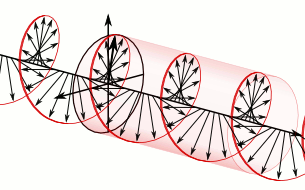Reading this question Why aren't charged particles constantly shining? I'm curious about how neutrons (in opposition to charged particles) and EM radiation interact.
According to this question Would electromagnetic radiation impart a pressure on a surface of neutrons? anna pointed out:
Again thinking in term of photons, i.e. individual interactions , tells us that the photons will be scattering on the neutrons because the neutrons have a magnetic moment (spin) and therefore a magnetic field and the photons will interact with that.
Does this mean that a neutron gets accelerated from a beam of photons?
Answer
When you say "accelerated by a beam of photons," I assume you have in mind a process like Compton scattering, where a charged particle interacts with a photon by elastically exchanging energy and momentum. This relationship is quite general; for example, you can qualitatively describe synchrotron radiation or brehmsstrahlung as scattering of charged particles from virtual photons.
In fact the relationship between accelerating particles and radiation is even more general than that: it arises from conservation of energy and momentum in electrodynamics. If an interaction with the electromagnetic field causes some particle to change its momentum, the "lost" momentum must be carried away by the electromagnetic field; the way that the electromagnetic field carries momentum is photons. Also electromagnetism is time-symmetric, so incoming photons must be able to change the energy and momentum of particles that act as field sources. The same set of arguments apply to angular momentum, as well.
A handwaving, semiclassical way to think about Compton scattering is that the incident photon is part of standing oscillation in the electromagnetic field, and that charged particles see the electric part of this oscillating field and get accelerated. The neutron, with zero electric charge, can't participate in this process. But the neutron does have a magnetic dipole moment, and like a bar magnet has a preferred orientation in a magnetic field. Imagine a magnetic dipole interacting with circularly polarized light, where the magnetic field vector always has the same magnitude but its direction changes continuously:
One low-energy configuration for this system is for the bar magnet to change its orientation in phase with the rotating magnetic field: that is, for the electromagnetic field to give angular momentum to the magnet. Any magnetic system that absorbed energy and angular momentum from such an electromagnetic field would have to absorb the linear momentum from the field as well, so such an interaction would accelerate the bar magnet.
For real photons and real neutrons there are some special criteria that have to be satisfied for this interaction to take place. The neutron's magnetic moment is tied to its spin angular momentum, which is quantized; therefore each neutron can only absorb a single photon, changing its angular momentum by $\hbar$, from a circularly-polarized ensemble of photons. (Note however that linearly-polarized light, and unpolarized light, can be described as a superposition of both circular polarization states, so I suppose multiple interactions are possible in such an environment.)
There's also a frequency constraint on the light that can be absorbed: the neutron has to "want" to rotate at the frequency of the light. For neutrons in a magnetic field the relevant frequency is the frequency of Larmor precession of the spin about the magnetic field. Here's a description of a device that flips neutron spins in a ten-gauss magnetic field by filling a resonant cavity with 30 kHz photons --- more of an audio frequency than a radio frequency. Other frequencies are invisible to the neutrons.

No comments:
Post a Comment